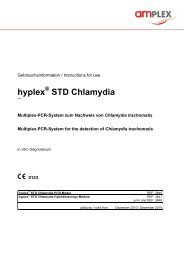hyplex SuperBug ID
hyplex SuperBug ID
hyplex SuperBug ID
Create successful ePaper yourself
Turn your PDF publications into a flip-book with our unique Google optimized e-Paper software.
nosocomial outbreaks. In Europe, although a number of IMP-type variants have been<br />
detected since the late 1990s, these enzymes appear to be considerably less common<br />
than VIM-type enzymes.<br />
NDM-1 was first identified in December 2009 and was named after New Delhi, as it was<br />
first described by Yong et al. in a Swedish national who fell ill with an antibiotic-resistant<br />
bacterial infection that he acquired in India. The infection was unsuccessfully treated in<br />
a New Delhi hospital and after the patient's repatriation to Sweden; a carbapenemresistant<br />
Klebsiella pneumoniae strain bearing the novel gene was identified. It was<br />
later detected in bacteria in India, Pakistan, the United Kingdom, the United States,<br />
Canada, Japan and several European countries. The most common bacteria that make<br />
this enzyme are Escherichia coli and Klebsiella pneumoniae, but the gene for NDM-1<br />
can spread from one strain of bacteria to another by horizontal gene transfer and was<br />
found in Morganella morganii, Providencia spp., Citrobacter freundii and Acinetobacter<br />
baumannii, too.<br />
Klebsiella pneumonia carbapenemase (KPC):<br />
The initial report of a KPC β-lactamase which is capable of hydrolysing carbapenems,<br />
penicillins, cephalosporins and aztreonam, was from a carbapenem-resistant K.<br />
pneumoniae strain isolated in USA, and subsequently KPC producers have also been<br />
detected in other regions all over the world. There are currently nine recognized<br />
variants, with KPC-2 and KPC-3 being more commonly isolated.<br />
Recently, isolates producing KPC-2 /-3 enzyme have been detected in European<br />
countries such as Greece, the UK, France and Germany. In addition, the spread of KPC<br />
producers may be underestimated, as the detection of KPC- and also MBL-producing K.<br />
pneumoniae may be unsuccessful because these enzymes do not always confer<br />
obvious carbapenem resistance.<br />
OXA-48 carbapenemase:<br />
The OXA-48-carbapenemase was first described in 2004 in a K.-pneumoniae-isolate<br />
from Turkey. Recently, isolates producing such carbapenemase were detected in<br />
various countries like Belgium, Israel, India, UK and Greece. In Germany it was found<br />
the first time 2008 in the south-western part of the country. Like in KPC-producing<br />
bacteria, the phenotypic detection of this resistence type seems to be difficult and<br />
unreliable.<br />
23




